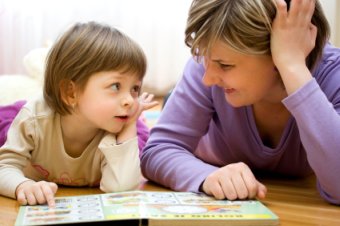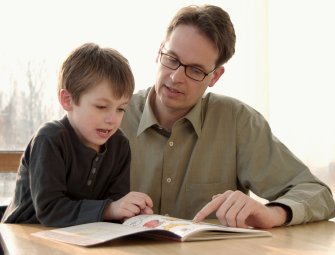What should your goal as a parent be when it comes to teaching your children reading?
The answer is very simple.
You must ensure they develop a love for reading.
Let me put it bluntly: Children reading regularly do well at school. Children who don’t like reading do not do well at school.
Think about yourself and others you know. Are you a good reader, do you love reading, have you read loads and loads of books? Yes? Congratulations – I bet you did well at school, were always towards the top of the class and aced all your tests.
Of course, I am generalising and there will be exceptions. But there is no question that a love of reading can turn an average kid into a top performer; a hatred of reading can turn an average kid into an underachiever.

Getting your children reading doesn’t have to be difficult or a chore. Here are some general steps to take (the ages are just a guide):
When your child turns four
By now, your child should be used to the idea of books, because you have been reading to them on a daily basis for years. (If you haven’t been doing this, don’t worry. Take a look at our Preschool Reading page you’ll get some great ideas for helping your child catch up.)
Reading time should be fun. Pick stories that are fun, read them with expression, ask your child questions, listen to their answers, engage in discussion.
Above all, you need to do this regularly – every day if possible. You’ll probably find that your child enjoys it so much he/she will be begging you to read to them.
Teach your child the alphabet
Kids’ tv shows, attendance at pre-school and general observation allow many kids pick up the alphabet quite easily. Another good method is to teach the alphabet by song.
Teaching children reading obviously requires more than just teaching them the letters of the alphabet but they will need to know them sooner or later, so why not make it sooner.
Teach your child some sight words
Sight words are words that the child recognises by sight – without necessarily understanding what the individual letters within the word mean. To an extent this will happen naturally – many common brands (eg Coke, McDonalds) are so recognisable that young kids soon know what these words mean without any help from you.
Teaching about twenty sight words is the first step towards teaching reading. The words are all common nouns – simple words like ‘mom/mum’, ‘dad’ and ‘baby’, along with some of the most comonly encountered words in English such as ‘a’, ‘and’ and ‘the’.
A good way to teach these words is with pictures – you teach the child to associate the word ‘mom/mum’ with the picture of a mother.
Age five
Once your child has learned their sight words, it is time to start showing them what the letters mean. The best way to do this is to take one of the sight words (we’ll use ‘dad’) and point to the first letter.
‘Look at that. That says duh. Duh for dad.’
Then point to a picture of a dog with the word ‘dog’ written above it.
‘And look at this word. See this says duh. Duh for dog.’
Soon enough your child will be on the lookout for words beginning with ‘d’ and will recognise the sound.
As your child starts school they will come home each day knowing just a little bit more than the last. With you helping them each night and with the teacher teaching them each day you will have a winning formula.
Sounding out
After you’ve taught some of the sounds of the first letters of the sight words to your kid, at some point either you or the teacher (or both) can teach them to sound words out.
This is simple and fun. Take the word ‘cat’. By now your child may well have learned the sounds made by all three of these letters. You can point to the word ‘cat’ and sound it out:
cccccccccccc
aaaaaaaaaa
ttttttttttttttt
And then say to the child ‘that spells cat’. And give them some practice in doing it.
Starting to read
It’s around this time that in addition to you reading each day to your child, they can start to read to you.
At this point, don’t forget:
1. It has to be fun
2. They’ll get there in the end!
So don’t stress if you think they should be faster than they are – as long as they are still enjoying it it will be okay.
Some kids like to show off their knowledge, some kids can be shy and of course sometimes children vary this behaviour. If your children enjoy showing a grandparent or aunt that they can read a word then by all means let them. But if they are shy, do not force them – a sure way to stop the development of children reading is for them to associate reading with fear or embarrassment.
When your child is reading, help them out when needs be, again using your instincts. If they get to a word they don’t know and you sense they want to sound it out for themselves then give them a chance to do so. But if they are in need of help give it to them. Intelligent assistance from you will keep the story moving along – you do not want to get bogged down – after all up till now the child has been used to listening to fun stories that you have read to them, the last thing you want is for them to get bored reading very simple stories slowly.
Practice
As children start to improve, more of the same is required! Reading must be a daily event – still consisting of you reading to them, but more and more, of your children reading to you. As they gain in ability you can introduce them to or help them understand some of the rules of English.
Some of these include the pronunciations of:
– th, ch and sh
– ee, ea and gh
Six and seven years
These years are about taking your kid from being able to read simple books on a rapid journey in which speed and vocabularly explode. If all goes well this will be the time that your child fully develops their love of reading and begins to read for fun.
At this stage, it is great to appeal to your child’s competitive instincts – even if only competing again st themselves. There are many series of books which start at a very simple level, and then book by book get gradually harder. Children love the idea of reaching targets – so start them on book one of a series of this kind and every time they conquer a level make a big song and dance about it. The satisfaction of achievement your child will feel will be matched by your own delight at what a proficient reader they are turning into.
st themselves. There are many series of books which start at a very simple level, and then book by book get gradually harder. Children love the idea of reaching targets – so start them on book one of a series of this kind and every time they conquer a level make a big song and dance about it. The satisfaction of achievement your child will feel will be matched by your own delight at what a proficient reader they are turning into.
Eight years
Whenever you see young children reading for pleasure, you know that they are going to be fine. Teachers who catch children reading a novel rather than doing their assigned work know that these are likely to be the smart kids.
So how can you get your children reading for pleasure? Easy: introduce them to some of the many wonderful children’s books available.
Enid Blyton’s books and the Harry Potter series are two examples.
Once your child has reached this stage you should be extremely proud. You have achieved one of the major goals of parenting and equipped your child with the skills to succeed academically.
Beyond elementary school
As your child moves beyond elementary (or primary) school they are ready to start reading books aimed at an older audience – indeed, many kids in their early teens are easily able to understand books intended for adults.
Our top three books for children in this age group are:
1. Magician by Raymond E Feist
2. Harry Potter by JK Rowling
3. Tomorrow, When the War Began by John Marsden
